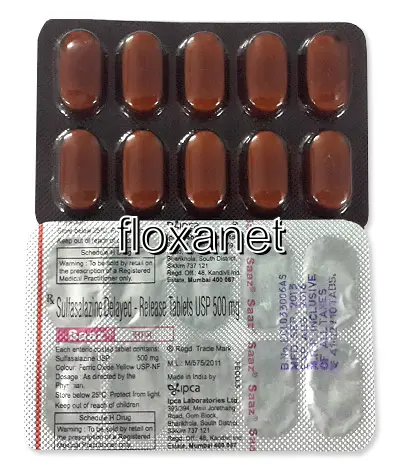Buy Sulfasalazine Online in New Zealand
| Package | Dosage | Price | Price per Dose | |
|---|---|---|---|---|
| Dosage: 500mg | ||||
| 360 pill | 500mg | NZD928.07 | NZD2.58 | |
| 270 pill | 500mg | NZD723.16 | NZD2.68 | |
| 180 pill | 500mg | NZD530.31 | NZD2.94 | |
| 120 pill | 500mg | NZD388.09 | NZD3.23 | |
| 90 pill | 500mg | NZD310.95 | NZD3.45 | |
| 60 pill | 500mg | NZD228.99 | NZD3.83 | |
| 30 pill | 500mg | NZD142.20 | NZD4.70 | |

Sulfasalazine Description
Overview of Sulfasalazine
Sulfasalazine is a medication commonly used to treat inflammatory conditions, notably ulcerative colitis and Crohn’s disease. It belongs to the class of drugs known as aminosalicylates, which work by reducing inflammation in the bowel. This medication has been in use for many decades and remains an important part of managing chronic intestinal disorders. Its efficacy in controlling flare-ups and maintaining remission makes it a preferred choice for many patients.
How Sulfasalazine Works
The medication functions through the combined action of its components, sulfapyridine and mesalazine. Once ingested, sulfasalazine is broken down in the colon by bacteria, releasing these active parts. The mesalazine acts directly on the intestinal lining to suppress inflammatory activity, while sulfapyridine has an additional anti-inflammatory effect. This targeted approach helps alleviate symptoms such as abdominal pain, diarrhea, and rectal bleeding associated with inflammatory bowel disease (IBD). The dual mechanism is particularly effective in reducing inflammation locally within the intestinal walls.
Usage and Dosage
Patients are usually advised to start with a lower dose, gradually increasing as prescribed by their healthcare provider. The typical course involves taking the medication multiple times a day, with doses tailored to the severity of the condition. It is important to follow the prescribed schedule precisely to maximize effectiveness and minimize potential side effects. Since sulfasalazine can interact with other medications, informing your doctor of all the drugs you are taking is essential. Regular monitoring, including blood tests, may be recommended to check for adverse reactions, especially during long-term use.
Possible Benefits of Sulfasalazine
Many users report significant improvements in their symptoms with consistent use of sulfasalazine. Its ability to reduce relapses of ulcerative colitis or Crohn’s disease makes it a valuable medication for long-term management. Patients often experience fewer flare-ups and an improved quality of life. Additionally, because it specifically targets inflammation in the gut, systemic side effects tend to be less common compared to some other immunosuppressive drugs.
Potential Side Effects and Risks
Like all medications, sulfasalazine can cause side effects. Common ones include nausea, loss of appetite, and mild abdominal discomfort. Some patients may experience allergic reactions characterized by rash, fever, or joint pain. Rare but serious side effects include blood disorders such as leukopenia or anemia, as well as liver toxicity. To mitigate these risks, regular blood work is often necessary when using this medication long-term. Patients should promptly report any unusual symptoms to their healthcare provider.
Patient Experience and Considerations
Many users find sulfasalazine effective and manageable, especially when they have proper medical supervision. Adherence to the prescribed regimen is crucial for optimal results. Some individuals may need to tolerate initial side effects that typically lessen over time. Others might require alternative medications if adverse effects are severe. Dietary adjustments and staying well-hydrated can also help improve tolerability and reduce gastrointestinal discomfort.
Conclusion
Sulfasalazine remains a cornerstone in the treatment of inflammatory bowel diseases. Its ability to control inflammation locally within the gut makes it a valuable medication for maintaining remission. While side effects can occur, with proper medical guidance and monitoring, many patients experience significant benefits. It is important to have realistic expectations and maintain regular communication with healthcare providers to ensure safe and effective use of this medication.
See Also
